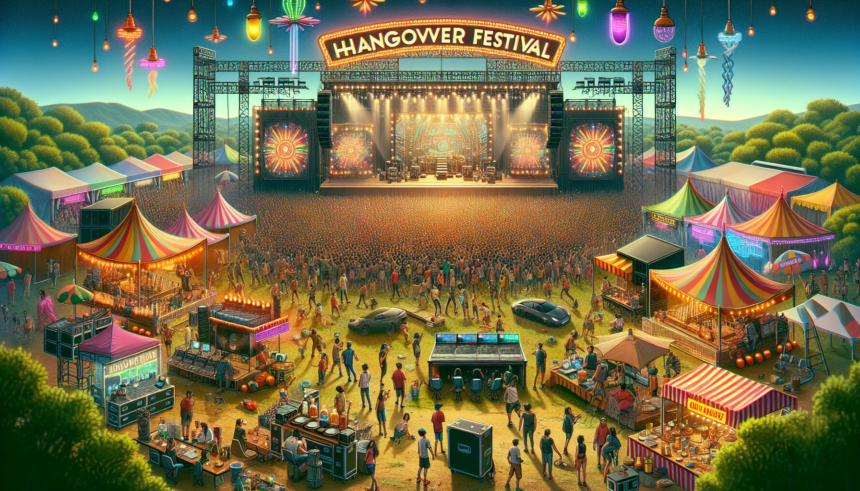The HangOver Festival, renowned for its eclectic mix of music, art, and cultural experiences, is a highlight on the festival calendar. From its humble beginnings to its current status as a globally recognized event, the festival has grown exponentially. However, what many attendees don’t see is the extensive planning, coordination, and hard work that goes into creating this extraordinary experience. Let’s take a closer look at what happens behind the scenes in making the HangOver Festival a reality.
Initial Concept and Vision
Like any great event, the HangOver Festival begins with a vision. The initial brainstorming stage involves a core team of creative minds who gather to outline the festival’s themes, objectives, and scope. This phase is critical as it sets the tone for the entire event. Questions like “What unique experiences do we want to offer?”, “Which artists or performers should we feature?”, and “How can we make this year distinctive?” are thoroughly discussed. The conceptual phase requires imagination, innovation, and a deep understanding of the audience’s desires.
Securing the Venue
One of the most crucial steps in planning the HangOver Festival is securing the perfect venue. The location must meet several criteria, including capacity, accessibility, and the ability to accommodate various stages, art installations, and camping areas. The site selection process involves extensive research and negotiations. Often, multiple locations are considered, with team members visiting each site to evaluate its potential. Once a venue is secured, logistical planning can begin in earnest.
Booking Performers and Artists
A festival’s success hinges on its lineup, and curating a diverse and exciting roster of performers is no small feat. The HangOver Festival aims to showcase a blend of established acts and emerging talent across multiple genres. The booking process involves reaching out to artists, negotiating contracts, and coordinating schedules. Timing is everything; securing headliners early can help attract other artists and build momentum. The team also works to create a balanced lineup that offers something for everyone, from mainstream hits to niche genres.
Logistics and Infrastructure
With the venue and lineup secured, the focus shifts to logistics and infrastructure. This encompasses everything from stage construction to power supplies and sanitation facilities. The logistics team works tirelessly to ensure that all physical aspects of the festival are meticulously planned and executed. This includes arranging transportation for equipment and personnel, setting up sound and lighting systems, and ensuring compliance with safety regulations. Detailed contingency plans are also developed to address potential challenges such as adverse weather conditions or technical issues.
Sponsorship and Funding
Funding is a critical component of the festival’s planning process. Securing sponsorships from brands and partners helps offset the significant costs involved. The sponsorship team seeks partnerships that align with the festival’s values and audience demographics. Negotiating deals that offer mutual benefits, such as brand visibility and interactive experiences, is key. Additionally, the festival may generate revenue from ticket sales, merchandise, and food and beverage vendors. A robust financial plan ensures the festival remains sustainable and profitable.
Marketing and Promotion
Effective marketing and promotion are essential for attracting attendees and creating a buzz around the event. This involves crafting a compelling narrative, designing eye-catching promotional materials, and leveraging various media channels. Social media plays a pivotal role, with strategic campaigns on platforms like Instagram, Twitter, and Facebook to engage potential festival-goers. Partnerships with influencers, press releases, and teaser videos also form part of the marketing strategy. The goal is to build anticipation and excitement leading up to the festival.
Health and Safety
A paramount concern for any large-scale event is the health and safety of attendees, performers, and staff. Rigorous safety protocols are established, including crowd control measures, emergency response plans, and coordination with local authorities. Medical tents, security personnel, and communication systems are put in place to handle any incidents. Additionally, environmental sustainability initiatives, such as waste management and eco-friendly practices, are implemented to minimize the festival’s impact on the venue and surrounding areas.
The Final Countdown
As the festival date approaches, the intensity of the preparations escalates. Final checks and rehearsals are conducted to ensure everything runs smoothly. Teams work around the clock to set up stages, install art pieces, and coordinate last-minute logistics. Volunteers are trained and briefed on their roles and responsibilities. The atmosphere is a mix of excitement and controlled chaos, with everyone focused on delivering an unforgettable experience. Communication is crucial, with regular meetings and updates to address any emerging issues.
During the Festival
On the day of the festival, the behind-the-scenes operations continue to be a hive of activity. Stage managers coordinate set times and technical crews to keep performances running seamlessly. Security teams manage crowd control and ensure the safety of all attendees. Hospitality staff cater to the needs of artists and VIP guests. Meanwhile, the logistics team monitors all aspects of the infrastructure to address any issues promptly. The festival’s success is a testament to the meticulous planning and hard work of the entire team.
Post-Festival Wrap-Up
Once the festival concludes, the work is far from over. The wrap-up phase involves dismantling stages, cleaning the venue, and conducting a thorough review of the event. Feedback is gathered from attendees, artists, and staff to identify areas for improvement. Financial reports are compiled to assess the event’s profitability and the performance of sponsors and partners is evaluated. The team also starts planning for the next edition, leveraging insights and experiences from the current year to elevate future festivals.
Conclusion
The HangOver Festival is more than just a weekend of music and fun; it is the culmination of months of hard work, creativity, and dedication from a passionate team of professionals. Every aspect, from the initial concept to the final wrap-up, involves meticulous planning and coordination. The festival’s success is a testament to the power of collaboration and the shared goal of creating an unforgettable experience for all who attend. Behind the scenes, countless hours and efforts ensure that each edition of the HangOver Festival is bigger and better than the last.
Frequently Asked Questions (FAQs)
1. How long does it take to plan the HangOver Festival?
Planning for the HangOver Festival typically begins a year in advance. This allows ample time for securing the venue, booking artists, arranging logistics, securing sponsorships, and promoting the event.
2. How are artists selected for the festival lineup?
The selection process involves curating a diverse mix of performers across various genres. The booking team reaches out to artists, negotiates contracts, and coordinates schedules. Feedback from previous attendees also helps shape the lineup.
3. What measures are in place to ensure attendee safety?
Comprehensive safety protocols are established, including crowd control measures, emergency response plans, medical services, security personnel, and coordination with local authorities to ensure the safety and well-being of all attendees.
4. How is the festival funded?
The festival is funded through a combination of ticket sales, sponsorships, and partnerships. The sponsorship team works to secure deals with brands that align with the festival’s values and audience demographics.
5. What happens if there are technical issues during the festival?
The logistics team prepares detailed contingency plans to address potential technical issues. There are always technical personnel on standby to quickly resolve any problems and ensure that the festival runs smoothly.





